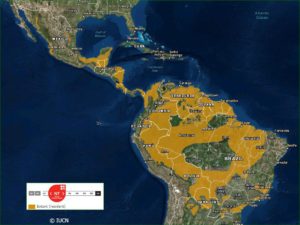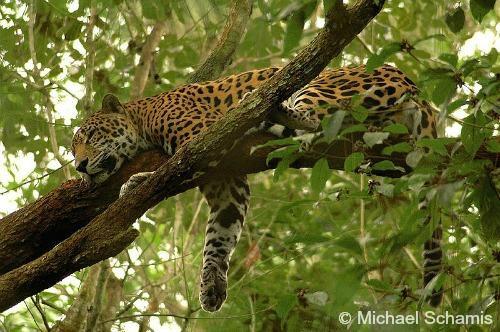- HB Length: 110-170 cm (43-70″)
- Tail Length: 44-80 cm (17-31″)
- Height: 66-74 cm (26-29″)
- Weight: 36-138 kg (70-304 lbs)
- Pop. Trend: Decreasing
Jaguars Panthera onca are the largest wild cats in the Americas. Often confused with the Leopard Panthera pardus in pictures, they would not be in the wild, due to the fact that the Leopard is found in Africa and Asia, while the Jaguar calls the Americas home.
Jaguars are relatively larger and heavier set than the Leopard, with a broader head and shorter, thicker legs and tail than the African cat. The short, stiff coat varies from pale gold through yellowish brown to a rusty red ground colour. The coat is marked with black spots on the head, neck, limbs, and dark blotches on the white to light buff underparts. The shoulders, back and flanks have spots, forming broken-edged rosettes that enclose one or more dots in a field darker than the ground colour. Melanistic individuals are occasionally reported, and appear to be more common among Jaguars than other large cats. The so-called ‘black panther’ has the same spots and rosettes, although they are difficult to see unless the animal is in direct sunlight. Forest Jaguars are not only more frequently darker, but are also considerably smaller than animals living in open areas. The largest cats are found in Venezuela and the Pantanal of Brazil.
The head is heavy set, with a broad muzzle, and irises of golden yellow to light greenish yellow. Their ears are relatively small, short and rounded, with black back sides and white central spots. The short, stocky legs have broad footpads, and the tail is relatively short and thick, entirely spotted, and black tipped.
Distribution

Commonly thought of as cats from the deep rainforest, Jaguars also inhabit seasonally flooded lowland rainforest, swampy grasslands, evergreen forests, dry scrub forests and mangrove swamps. They are strongly associated with the presence of water, and sightings of the big cat in Arizona desert habitat are not far away from the Rio Grande river.
While Jaguars have been reported from elevations as high as 3,800 metres in Costa Rica, they have not been found above 2,700 metres in the Andes.
Today the Jaguar’s range extends from extreme southern Arizona in the USA, through the tropical forest of Central and South America to northern Argentina. They have lost more than 50% of their historic range, but there is some evidence that enough connectivity remains between the northern and southern portions of their range.
Home range sizes vary from 33 km2 (males) and 10 km2 (females) in the Yucatan Peninsula, to 142 km2 for both sexes in Brazil. Home ranges of males typically enclose the territories of two females. Population densities range from 7-8 cats/100 km2 in Belize to 6-7/100 km2 in the Pantanal of Brazil; 4-5/100 km2 in the Amazon Basin and 2-3/100 km2 in Bolivia.
Ecology
Although they are very good climbers, most of their hunting is done on the ground. More than 85 species have been recorded in the diet of this opportunistic predator. Prey is usually stalked or ambushed, and carcasses may be dragged some distance to cover. While large prey such as tapirs, peccaries, and deer are preferred, Jaguar will eat almost anything they can catch. Cattle are often ranched on prime Jaguar habitat, and are the most frequent prey species taken in Brazil and Venezuela.
Primarily nocturnal, radio telemetry studies have shown they may also hunt during the day, with activity peaks at dusk and dawn. They are basically solitary and territorial, marking mostly with urine. Jaguars are excellent swimmers able to cross wide streams and even swim the Panama Canal.
Jaguars can move through any landscape that offers enough fresh water and some cover – forests, ranches, plantations, citrus groves and village gardens. They travel mostly at night.
Reproduction
The female is polyestrous year round, with no specific breeding season over most of their range. In the northern part of their range, breeding appears to take place in December and January, with cubs being born in April and May. At birth, cubs are furred with a long, woolly, pale buff pelage, heavily marked with round, black spots and narrow, black facial stripes. A female’s receptive period lasts about 13 days. One to four cubs are born after a gestation period of 90 – 105 days. They weigh 700 – 900 grams at birth, open their eyes after 11 – 13 days, start walking around 18 days, eat solid food at around 70 days, and are weaned at four to five months of age. The young stay with the female for up to two years, and attain full size and sexual maturity at two to three years for females, and three to four years for males. Captive animals have lived up to 22 years.
Conservation
Considerable ecological research and international collaboration are being directed to the future of this big cat. In particular, efforts to combat and manage human conflicts are part of that ongoing program, with creative work and local community involvement. Fighting the massive development of landscapes for human economic benefit remains an ongoing battle. Generally, the primary threat to the Jaguar is persistent loss of habitat across its range.
Over 182 potential wildlife corridors covering 18 nations and two continents have been identified within the Jaguar’s range. Concerted efforts are underway to negotiate agreements with the various countries involved to preserve this Jaguar genetic highway.
Biologists once thought there were eight distinct subspecies of Jaguar roaming the Americas. Recent genetic analysis however, has shown that no Jaguar group had split off into subspecies. From Mexico deserts to the Pampas grasslands of Argentina, Jaguars had been wandering great distances to breed with each other.
Jaguars are thought to have evolved from a leopard-like ancestor in Eurasia, and to have immigrated to North America via the Bering land bridge. Initially larger than they are now, a decrease in size and a shortening of the limbs is thought to have happened during the Pleistocene. This shortening of the legs may be an adaptation to being active in a three dimensional world of climbing, running and swimming.
Their name comes from ‘yaguara’, a native Indian term which, loosely translated, means ‘a beast that kills its prey with one bound’. Many Central and South American native tribes had Jaguar images as a dominant feature of their cultures. Throughout Mayan history, the Jaguar symbolized the night sun of the underworld, which personified fear, night terrors and death. The Amazonian Indians believed that the sun created the Jaguar as his representative on earth. The Olmecs of Mexico, as well as many other peoples, deified these cats and built massive monuments devoted to their worship.
Compare the Jaguar to the similar Old World Leopards.
Range map IUCN Red List 2008
Updated 2014
Saving the Jaguar Through a Camera Trap
Dustin Ingram is a university student in Ohio. Students there were tasked with creating a platform to inform others of a unique technology being used in conservation efforts. He decided to raise awareness on how camera traps are being used to conserve Jaguars, more specifically in the development of corridors. Here is Dustin’s excellent video!


Pat Bumstead
No, jaguars have never lived in Canada – our only big cat is the cougar. A hundred thousand years ago there were cheetahs in The Americas but that’s the only large spotted cat ever in Canada and that was a long time ago! Great question though and I hope other readers can answer it!
Angela
Did jaguars ever lived in Canada?
Why do some Canadian totems in BC apparently depict jaguars?
Anthony
Cool!!